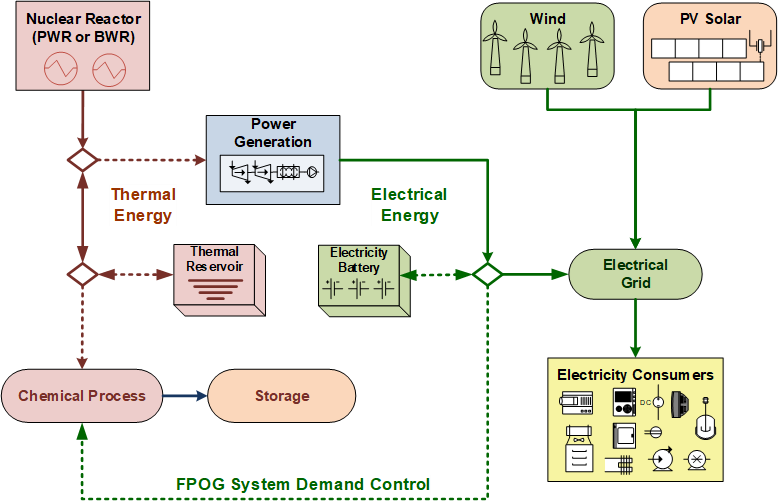FLEXIBLE PLANT OPERATION AND GENERATION
BackgroundA number of U.S. light water reactors (LWRs) have faced increasing economic pressure arising from the historically low cost of natural gas and the correspondingly low operating costs of natural-gas combined-cycle power plants, combined with an increase in renewable-energy capacity (specifically solar and wind) on the power grid. However, nuclear power provides specific and unique advantages to the electric grid: resiliency, reliability, emergency backup, all-weather operation, and enhanced national security, all while providing carbon-free power. Technical and economic assessments (TEAs) for hydrogen and hydrogen-user industries were completed by the LWRS Program in 2019 and 2020, building upon previous accomplishments of the NE Program for Crosscutting Technologies Development and the DOE-Office of Energy Efficiency and Renewable Energy's (EERE's) Hydrogen and Fuel Cell Technology Office (HFTO).
Flexible plant operation and generation (FPOG) is required to supply energy to an industrial process. FPOG operations provide an offtake opportunity—that is, an agreement to purchase a future product—for energy produced by a LWR power-generating station when the price offered for committing electricity to the grid is lower than the cost of producing this electricity. In summary, four fundamental principles underscore the need for LWR FPOG research and development (R&D): Thermal energy from an LWR is economically competitive. Calculations have shown the existing fleet of nuclear reactors can reliably produce cost-competitive, moderately high-pressure steam (5.2 MPa, ~300°C) for the projected life of a large capital-investment project. Nuclear energy has very low emissions. In a world that is placing increasing value on low-emissions energy sources, LWRs have a value proposition as a clean-energy, low-carbon, energy source that is similar to that of renewable energy. FPOG systems can support energy storage. LWR FPOG can be conveniently designed for thermal- and chemical-energy storage, with the possibility of using this stored energy to produce power that matches diurnal-demand cycles or peak-season demands. Nuclear power generating stations provide important reliability and resiliency. FPOG systems can help maintain the grid resiliency that becomes increasingly important with the buildout of renewable energy.
Research and Development Purpose and Goals
The purpose of the FPOG Pathway is to diversify and increase the revenue of LWRs in the U.S. This Pathway supports TEAs to raise the understanding of LWR owners, investors, utilities, and industrial manufacturing and transportation-sector industries. It supports essential R&D required to enable LWR plants to dispatch both thermal and electrical energy for production of nonelectrical products through FPOG. This work focuses on interfaces between the LWR plant and the industrial-energy user that enable an LWR plant to optimize its revenue through production of electricity and nonelectrical products. It addresses the potential safety hazards of collocated hydrogen and chemical on operating licenses and system-integration interaction with LWR operations.
Safety AssessmentsThe goal of this effort is to ensure the FPOG remain within the operating basis of LWRs or to otherwise inform plant owners on license modifications for relatively large percentages of LWR thermal-energy delivery to an industrial user. Thermal-Energy DispatchThe purpose of this activity is to address reactor operator and other use‑case human-factors and control-systems R&D that are needed to dynamically extract and deliver thermal energy from a nuclear power plant for use by an industrial process. Design and EconomicsThe purpose of this activity is to complete TEAs to evaluate market opportunities for LWRs that will supply electricity and steam or heat to produce non-electricity products. |